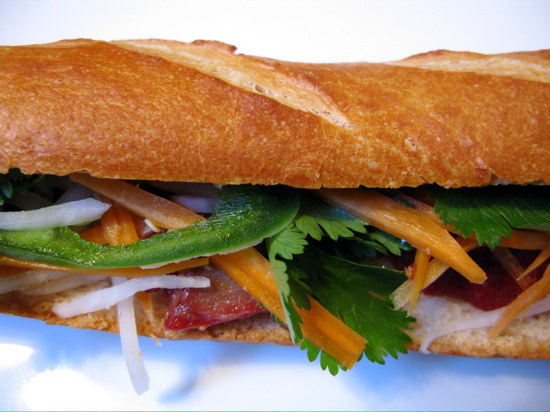One of the perks of working in Silicon Valley for so long was the little ethnic restaurants found at virtually every strip mall. You could eat your way around the world without ever leaving the South Bay. And I did.
From Salvadoran pupusas in a converted burger shack to Indian dosas in a barely remodeled coffee shop, I discovered vibrant flavors and delightful textures in unexpected places. One of the things I’ve missed the most since leaving the Mercury News is the Vietnamese sandwiches, banh mi, that I used to grab for a quick lunch at least once a week at the hole-in-the-wall shop not far from my office.
They weren’t the best banh mi I’ve ever tasted, but the slender baquettes were fresh and crusty, the filling was lively, and they were astonishingly cheap: just $2.50. At that price, I never even considered making them at home.
After the only Vietnamese sandwich shop I knew in nearby Santa Cruz closed, it seemed banh mi were out of my reach on this side of the mountains. Many cooks make them with the Mexican sandwich rolls known as bolillos, but I craved the thin baguettes with a high proportion of crisp crust to soft interior. Local bakery’s baguettes, though excellent, tended to be much too fat for the purpose.
Then on a recent road trip, we picked up a skinny baguette at a Von’s supermarket in Southern California to go with dinner and an idea was born. It wasn’t the same as the Vietnamese bread, which usually has a thinner crust and softer center, but it was close enough and I realized I could find a similar loaf at my local Safeway, which belongs to the same corporation. The filling would just be a matter of experiment.
Some people like to call these sandwiches Saigon subs, but I think that gives the wrong impression. The banh mi I love are not overloaded meat bombs. A little barbecued pork or chicken, a spoonful of pickled carrot and radish salad, a few springs of cilantro, a couple of slivers of jalapeno and perhaps a slice or two of cucumber are typical fillings, although almost any meat will do. The classic is Vietnamese pate, but ham is popular and so are roast pork and even sardines.
Andrea Nguyen, author of the James Beard nominated Into the Vietnamese Kitchen: Treasured Foodways, Modern Flavors (Ten Speed Press, 2006), favors plenty of good mayonnaise spread on the bread, too, and a touch of soy sauce or Maggi seasoning. I’m just as happy with a little butter, which doesn’t compete with the fillings.
The tricky part for me was getting the carrot and daikon radish salad right. Sweet, sour and crunchy, it’s critical to a first-rate banh mi, but most of the recipes I tried were too bland and watery. I like it with plenty of vinegary tang. That meant more rice vinegar and less water and sugar. Once I hit the right balance, I was set.
My sandwich may not be strictly authentic, but it makes me happy with its great textures and bright flavors. Now I don’t have to drive 40 miles to get my fix.
serves 1
10-inch section of a slender sweet baguette
Butter
Several thin slices of barbecued pork or other meat, warmed
¼ cup pickled carrot and daikon salad (recipe follows)
4 or 5 sprigs cilantro
2 or 3 thin slices jalapeno, to taste
Slice bread horizontally almost all the way through so it opens like a book and toast for a few minutes in the oven. Remove some of the interior crumb to make room for the filling and butter lightly. Layer meat, carrot and daikon salad, cilantro and jalapeno evenly over the bottom portion of the baguette. Fold top back over the filling, slice in half vertically and eat.
PICKLED CARROT AND DAIKON SALAD
Makes about 2 cups
½ pound carrots
½ pound daikon radish (see Note)
1 teaspoon Kosher salt
½ cup rice vinegar
¼ cup water
3 tablespoons sugar
Peel carrots and radish and cut into long matchsticks using a knife or vegetable slicer. Alternatively, grate on the coarse holes of a box grater. Place in a colander, sprinkle with salt, toss and let stand for 30 minutes.
In a small non-reactive pan, bring vinegar and water to a simmer. Stir in sugar until dissolved. Remove pan from heat and let mixture cool to room temperature.
Rinse carrots and radish, squeeze out excess liquid and transfer to a bowl. Pour vinegar mixture over vegetables, stir well and let stand for at least 1 hour. Overnight is better.
Stored tightly covered in the refrigerator, the salad will last for at least a week.
Note: Daikon is a large white radish with a mild flavor. It is now found readily at many supermarkets. When it grows too large, it can be tough and fibrous. Try to get a smaller radish, no more than 2 inches in diameter.
Aleta Watson

